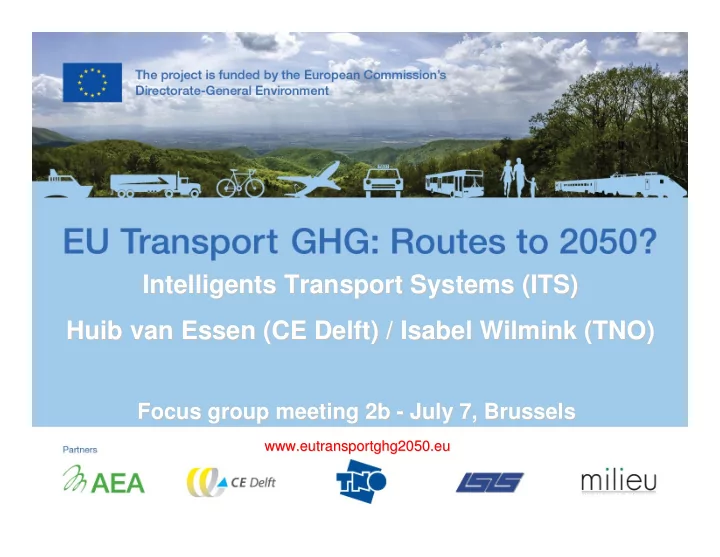

Intelligents Transport Systems (ITS) Transport Systems (ITS) Intelligents Huib van Essen (CE Delft) / Isabel van Essen (CE Delft) / Isabel Wilmink Wilmink (TNO) (TNO) Huib Focus group meeting 2b - - July 7, Brussels July 7, Brussels Focus group meeting 2b www.eutransportghg2050.eu www.eutransportghg2050.eu 1
Variants of ITS • Driver assistance systems • Traffic management • Traffic information systems • ITS may be located in: – Vehicles – The infrastructure (roadside) – In the vehicle without being part of the vehicle (nomadic devices) • Main areas of application: – Safety − Relates to emissions reduction by decreasing the accident related congestion − May lead to reduced ‘hardware’ safety requirements and thus reduced weight (?) – Improving traffic throughput – Reducing emissions 2
Developments in ITS future transport cooperative systems systems network-wide approach solitary measures 1980 1990 2000 2010 2020 2030 2040 1. Solitary measures (local traffic management or in-car adaptive cruise control) 2. Network-wide approaches (for traffic management), requires – Improved data collection – Improved processing methods – Algorithm development 3. Cooperative systems (vehicle-to-vehicle or vehicle-to-infrastructure communication) 4. Future systems (2050): traffic management integrated with driver assistance and information systems 3
ITS and emissions reduction (means) • Reduce the number of kilometers traveled • Optimize the average speed • Optimize the traffic composition – E.g. by means of congestion charging • Optimize the vehicle dynamics – Congestion is only small part of all kilometers driven (reducing congestion has little effect) – Less congestion may lead to more • For all but the highest average velocities, traffic (which has a negative impact on the measures to reduce vehicles dynamics, GHG emissions) i.e., reducing accelerations and – Influencing driving dynamics is most decelerations, will reduce the CO2 efficient if this applies to a large part of emissions, by 5% to 20%, for the same the road network (the efficiency of local powertrain technology measures is not significant) 4
ITS and emissions reduction (systems) Eco solutions Eco driving assisted by Energy use indicator and Gear shift indicator, Map-enhanced eco driving, Automatic engine shutdown, Fuel efficiency advisor, Tyre pressure indicator Stand-alone (in-car) (Adaptive) cruise control, Lane keeping assist, Emergency systems braking, Fuel efficient route choice, Pay As You Drive (PAYD), Speed Alert Advanced traffic Congestion charging, Road charging, Dynamic speed limits, management Dynamic traffic light synchronisation, Green waves, Slot management, Freight trip planning systems Cooperative systems Cooperative adaptive cruise control, Congestion assistant, Platooning, cooperative traffic lights Future Optimization of ITS w.r.t. emissions reduction (requires that measures must be accepted by the driver) 5
Cost of ITS • Infrastructural requirements (May decrease over time because of increasing in-vehicle or vehicle-to-vehicle system performance) – Service providers − Personnel – Traffic management centres – Monitoring and data processing facillities – Computer servers – Variable road signage – Sensors • Software – ICT • Hardware – Infrastructural requirements – In-vehicle requirements − Sensors − GPS • PR/marketing 6
Barriers • Systems can be difficult to implement because of the amount of stakeholders – Organisational issues – Legal issues • High initial investments • Difficult to reach sufficient penetration rates – Many systems don’t make it past the trial stage – Penetration is unpredictable and system dependent • For high effectiveness of advisory systems, high compliance is needed 7
Issues • The effect of ITS is highly dependent on local conditions • There exist few quantitative evaluations of ITS with respect to GHG emissions – Suitable modelling approaches are currently being developed Several field tests are taking place in 7 th framework projects – • Few studies look beyond 2020 • Co-benefit: ITS measures that reduce emissions are likely to decrease noise annoyance because of increasing driving smoothness and decreasing congestion. 8
Open questions • Role of ITS in 2050? • How does ITS affect emissions in 2050? – Likely to facilitate a transport increase – Effect on average speed? – Traffic composition in 2050? – Relation between vehicle dynamics and emissions in 2050? 9
Recommend
More recommend